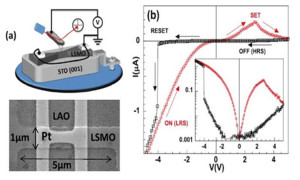Nanodevices
Nanodevices
Local Joule Heating
[slideshow_deploy id=’595′]
One of the controversial issues when applying high voltage bias to a material is the relative importance of power dissipation, i.e., Joule heating and the disentanglement of intrinsic effects to those related with a local temperature change. This is particularly important in studying electroresistance, i.e., the change of resistance due to a pulse of current or voltage that may be used in the development of two-terminal non-volatile memory devices. To study this subject we design and fabricate planar devices where Pt thermometers are nanofabricated on top of microbridges to simultaneously measure temperature and IV curves.
Magnetic Tunnel Junctions
[slideshow_deploy id=’607′]
Magnetic tunnel junctions consist of two ferromagnetic electrodes separated by a thin insulating barrier. The resistance change between the parallel and antiparallel alignement of electrode magnetizations is called tunneling magnetoresistance, of interest for developing magnetic random access memories (MRAM). Tunneling current across the device mainly depends on the electronic structure of the barrier and the electronic properties of the electrode/barrier interface. Direct transport measurement across the interfaces is a powerful technique suitable for barrier characterization.
By combining optical and electronic lithography, we fabricate nanodevices that allow us to study magnetotransport properties of different tunnel junctions and to obtain important insights about the conduction mechanism and barrier typical parameters.
Resistive Switching
[slideshow_deploy id=’608′]
Complex oxide materials often exhibit reversible resistive switching, i.e, the interchangeability of the resistive state by applying a pulse of current or voltage. In the case of La0.7Sr0.3MnO3 manganite thin films this phenomenon has bipolar character meaning that the resistive switching curve shows directional behaviour depending on the bias polarity. To clarify the intrinsic mechanisms controlling this effect it is necessary to avoid standard capacitor-like geometries where metallic-insulating interfacial effects are involved. We microfabricate devices in which nanosized resistive states are induced by using a conducting scanning force microscopy tip and macroscopic resistance changes as a function of temperature and magnetic field can be simultaneously monitored.
